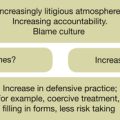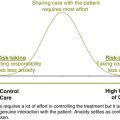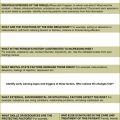Chapter 4 Understanding the risk
It is not sufficient to simply identify the risk and risk factors associated in order to manage the risk. It is also necessary to identify patterns which make the risk behaviour more likely and, to do this, the previous episodes of risk behaviour will need to be explored in as much detail as possible. It is from the analysis of previous episodes of risk behaviour that the patterns will begin to emerge. Further information which will yield more information about the patterns of risk are the elements of personal meaning which a patient will attach to the risk.
The process for exploring this information is termed the ‘anamnestic analysis’ (anamnesis — the recalling of things past). The term anamnesis has a long history in mental health work and refers more specifically to a reconstruction of the historical development of the behaviour.1 A structure for this aspect of the risk assessment, such as a chain analysis2 or functional analysis,3 may be used. The behaviour is examined step-by-step as closely as possible to try and pick up the antecedents as well as the behavioural and emotional consequences to the behaviour.
There are three main ways in which this information can be found:
1. taking the history from the patient
2. discussion with relatives and friends, other health care providers and so forth
3. examination of previous case files, criminal records and so forth.
It is very common for some of this information to be gleaned from previous case files. Taking the collateral history is a routine part of history taking within mental health practice and this is no different when undertaking a risk assessment.
Exploring past episodes of risk behaviour and identifying patterns
1. if the external environment and/or mental state match previous patterns, the level of risk is likely to be high
2. the patterns identified will lay the foundation for future interventions. From here, triggers and early warning signs can be identified, which can ultimately lead to relapse prevention work.
The importance of exploring previous risk episodes in detail cannot be emphasised enough.
The history of past episodes of risk behaviours needs to include:
• the mental state at the time — whether it occurred in the context of illness
• treatment at the time — whether medication was being taken
• the social circumstances at the time — when, where and to whom it happened
BOX 4.1 ANAMNESTIC ANALYSIS OF RISK
• A detailed analysis of past episodes of the risk behaviour should always be undertaken.
• Patterns of risk behaviours should be identified; critical risk factors and/or signature risk signs for individual patients can be identified from the patterns.
• A chain or functional analysis of events, thoughts and emotions leading up to the risk behaviour and following on from it can help in understanding the function of the behaviour.
• The exploration of the function can assist in elucidating pathways and patterns for the risk behaviour.
The function of risk behaviours — more detailed analysis
Exploring the function of the risk behaviour can be broken down into two parts. The first part is looking into the patient’s thoughts and feelings before the risk behaviour occurs. In the first example, the risk factor of the delusional belief is already present but for the patient to act on the delusional belief, he will need to go through the anguish of trying to work out whether he should kill his mother or not. In the example of the patient who is only violent in certain situations, a similar exercise would be undertaken of exploring the thoughts and feelings which are occurring for the patient prior to the risk behaviour occurring.
This is explored further in Chapter 16, Psychodynamic principles and boundary issues.






